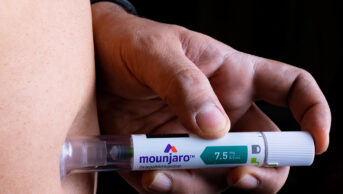
Koichi Fujii

Lowering the threshold is the right move
There is evidence that bariatric surgery is more effective for weight loss than non-surgical options so making it available to more patients can only be a good thing.
By David Haslam, GP and chairman of the National Obesity Forum UK
The recent move by the UK health watchdog the National Institute for Health and Care Excellence (NICE) is a step in the right direction. Evidence suggests that bariatric surgery is more effective than pharmacological and lifestyle intervention. But bariatric surgery is not a weight loss technique in itself, rather it is a tool to enable the dietary and lifestyle changes that a person must make less arduous and more effective. Nor is bariatric surgery undertaken instead of any course of treatment; it is conducted only alongside a change in behaviour by the patient, and possibly post-operative prescription of weight loss pharmacotherapy to aid weight maintenance.
It is already the case that bariatric surgery is the treatment of choice over lifestyle interventions or drug treatment for adults with a BMI of more than 50kg/m2 when other interventions have not been effective. The updated NICE guidelines broadens eligibility for patients to access bariatric surgery.
Previous NICE guidance was aimed at ensuring that obesity become a priority at strategic and delivery levels and, despite some strategic success, failed in terms of service delivery.
The new guidance makes it obligatory that all NHS patients referred for bariatric surgery undergo at least a year of specialist weight management services. While some counties of the UK offer exceptional service, such as Rotherham and Fakenham, other services are poor, and several are non-existent. Therefore, sometimes patients lose weight to the extent that surgery is no longer required, others languish in ineffective programmes, often gaining weight, and yet others cannot access surgery at all.
The guidance stipulates that all appropriate non-surgical measures must have been tried but the person has not achieved or maintained adequate, clinically beneficial weight loss and only after a person had received intensive treatment for weight loss.
In children, the NICE recommendations remain as before, that “surgery may be considered for young people only in exceptional circumstances, and if they have achieved or nearly achieved physiological maturity”, although the definition of near physiological maturity is fairly nebulous.
There are cases in which it is clear that bariatric surgery should be offered as an immediate first-line option — obese young patients who have poorly controlled diabetes with early microvascular complications, on escalating doses of insulin — although these patients must still undergo a year of intensive services only serving to delay surgery, and allowing health complications to accumulate.
The new guidance offers an expedited assessment for bariatric surgery to people with a BMI of 35 or over who have recent-onset type 2 diabetes, as long as they are also receiving or will receive intensive treatment. The guidance also advises considering an assessment for bariatric surgery for people of Asian family origin who have recent-onset type 2 diabetes at a lower BMI than other populations.
Bariatric surgery is a more effective intervention for weight loss than non-surgical options. In one large cohort study, weight loss was still apparent ten years after surgery, whereas patients receiving conventional treatment had gained weight[1]
. After surgery, statistically fewer people have metabolic syndrome and there is higher remission of type 2 diabetes than in non-surgical groups. In one large cohort study, the incidence of three out of six comorbidities assessed ten years after surgery was significantly reduced compared with conventional therapy[1]
.
In a systematic review, metabolic surgery has been shown to be superior to medical treatment for short-term remission of type 2 diabetes and comorbidities[2]
.
Safer than gall bladder surgery
Although not everyone newly diagnosed with type 2 diabetes will want or need bariatric surgery — many patients embrace lifestyle changes, lose weight and gain glycaemic control — for others the restrictive use of bariatric surgery is removed, and the surgical process can commence before much vascular damage has been done. Bariatric surgery is safer than gall bladder surgery[3]
and the cost-effectiveness itself relies on the reduced costs associated with comorbidities and other complications[4]
. The degree of improvement in the new NICE guideline is surprising, not only in expediting the process from decision to surgery, but also in recognising a special group of patients for whom speed is essential, including those with a BMI of 30, or even less in the case of certain ethnic groups.
Surgical management, although more costly than non-surgical management, offer better outcomes for patients. For morbid obesity (BMI greater than 40), incremental cost-effectiveness ratios (an equation used in health economics to provide a practical approach to decision making regarding health interventions) ranged from between £2,000 and £4,000 per quality-adjusted life years gained, which is within the range regarded as cost-effective from an NHS decision-making perspective. The Office of Health Economics, a health economics consultancy, has also stated that reductions in wider societal costs once former morbidly obese individuals return to work, including reduced social welfare benefit payments and increased tax revenue, will cover the cost of bariatric procedures to society within two years[5]
.
The day has arrived where a patient diagnosed with type 2 diabetes can be referred to have it surgically removed as if it were a gallstone.
NICE should be congratulated for grasping the nettle and improving guidelines for surgery. Hopefully in the next incarnation, some other flaws will be rectified.

More bariatric surgery? No thanks
Putting more people under the knife will not fix the problem of obesity and type 2 diabetes.
By David Katz, director, Yale University Prevention Research Center
Technically, I am opposed to the UK’s National Institute for Health and Care Excellence’s (NICE) decision to lower the threshold for patients eligible for bariatric surgery. But as much as we might like our policy debates distilled down to right or wrong and good or bad, there is often ineluctable nuance in the mix. This is one of those times.
So, frankly, I am not opposed to the recommendation in the world as it is. Rather, I am opposed to the world as it is, and the risk that this clinical guidance will help propagate a costly and eminently improvable status quo.
Type 2 diabetes is rampant. Projections in the United States estimate one in three people have it, and as many as one in two people will have the condition by 2050, should current trends persist[6]
. The rate of type 2 diabetes is rising alarmingly among younger people[7]
. The situation in the UK, and indeed an increasing swathe of the world, is much the same[8]
.
The evidence is clear that bariatric surgery has the potential to reverse type 2 diabetes, particularly if rendered soon after the diagnosis is made[9]
. The evidence is also clear that the major driver of pandemic type 2 diabetes is pandemic obesity and the lifestyle factors (such as poor dietary choices and lack of physical activity) that propagate it; and that no BMI cut-point is a reliable indicator of risk. Some individuals can have apparently good metabolic health with a BMI well above 35, while others are prone to insulin resistance, and type 2 diabetes, with excess adiposity at a BMI even well below 30[10]
.
Thus, the use of a BMI cut-point as the determinant of eligibility for any given therapy is arbitrary. By basing eligibility on a condition rather than a cut-point, the NICE policy is a rational step.
Lifestyle changes are the answer
The final element in this line of reasoning is that those 800,000 newly diagnosed diabetic patients are not going away without healthcare costs whether or not they are surgical candidates. The public can pay now, or pay later, but we will pay either way. Since surgery can potentially “cure” the diabetes, but standard medical treatment generally does not, there is a case for covering surgery and getting better clinical outcomes for expenditure that is inevitable either way.
But then again, there is something not right about relying on surgery to rectify what a societal commitment to better use of feet (i.e. routine physical activity) and forks (i.e. wholesome foods in sensible combinations[11]
) could prevent altogether[12]
.
The evidence has been clear for several decades[13]
[14]
that type 2 diabetes is preventable roughly 95% of the time. What drugs cannot do, and surgery does at high cost, lifestyle could do universally, inexpensively, and with ancillary benefits to all.
That, then, is the basis for my opposition to the NICE recommendation. Not that it is wrong in the world as it is. Rather, it potentially aids and abets the proposition that the world, as it is, is acceptable when it is not.
We could fix type 2 diabetes, and the obesity from which it originates, with knowledge readily in hand. We are drowning in calories engineered to be irresistible[15]
. We are drowning in labour-saving technologies that may be saving labour, but costing us our health and well-being. As with drowning of the more literal variety, the fix is a combination of personal empowerment — the anti-obesity skill set analogous to swimming — and public accountability at the water’s edge.
If we treated drowning like obesity, we would have no lifeguards at the beach. We would not teach our children to swim. We would allow signage at a shore with notorious rip tides to read: “Come on in, the water’s fine!” If, instead, we treated obesity more like drowning, we would tell the truth about food. We would not market multicoloured marshmallows to children as part of a complete breakfast. We would not wilfully mislead about the perilous currents in the modern food supply. We would not look on passively as an entire population of “non-swimmers” started wading in over their heads.
If liberalising criteria for bariatric surgery delivers effective care to those in need, while permitting, and ideally enhancing, attention to opportunities for prevention at the population level, it is all for the good. But the insidious danger in the NICE reaction to rising rates of type 2 diabetes is that proaction could be subordinated by it. Relying on scalpels may distract us from what we might achieve in schools. Relying on operating rooms may obscure the opportunity to use lifestyle as our medicine, and culture as the spoon that helps it go down.
Until and unless our cultures rally to this cause, there is a good case that surgery to reverse type 2 diabetes is far better than living with the disease and its complications. The BMI was never what really mattered; what mattered was whether excess body fat was adversely affecting health. In the case of type 2 diabetes, it clearly is. So, in fact, type 2 diabetes is a far more rational argument for therapeutic surgery than a given BMI cut-point ever was.
But that only makes the new recommendation nice for the world as it is. Accepting a prevailing cultural status quo that consigns ever more of our children to unnecessary metabolic mayhem is a travesty that redounds to our collective shame.
References
[1] Jones J, Colquitt JL, Gospodarevskaya E et al. The clinical effectiveness and cost-effectiveness of bariatric (weight loss) surgery for obesity: a systematic review and economic evaluation. Health Technology Assessment 2009;13:41–190, 215–357.
[2] Müller-Stich BP, Senft JD, Warschkow R et al. Surgical versus medical treatment of type 2 diabetes mellitus in nonseverely obese patients: A systematic review and meta-analysis. Ann Surg 2014 Nov 17.
[3] National Bariatric Surgery Registry. Surgeon specific outcome reports for bariatric surgery.
[4] Buchwald H, Avidor Y, Braunwald E et al. Bariatric surgery: a systematic review and meta-analysis. JAMA 2004;292:1724–1737.
[5] Shedding the pounds: obesity management, NICE guidance and bariatric surgery in England. Office of Health Economics, 2010.
[6] Gregg EW, Zhuo X, Cheng YJ et al. Trends in lifetime risk and years of life lost due to diabetes in the USA, 1985–2011: a modelling study. Lancet Diabetes Endocrinol 2014;2(11):867–874.
[7] Dabelea D, Mayer-Davis EJ, Saydah S et al. Prevalence of type 1 and type 2 diabetes among children and adolescents from 2001 to 2009. JAMA 2014;311(17):1778–1786.
[8] Oggioni C, Lara J, Wells JCK et al. Shifts in population dietary patterns and physical inactivity as determinants of global trends in the prevalence of diabetes: an ecological analysis. Nutrition, Metabolism and Cardiovascular Diseases 2014;24(10):1105–1111.
[9] Brethauer SA, Aminian A, Romero-Talamás H et al. Can diabetes be surgically cured? Long-term metabolic effects of bariatric surgery in obese patients with type 2 diabetes mellitus. Ann Surg 2013;258(4):628–636.
[10] St-Onge MP, Janssen I & Heymsfield SB. Metabolic syndrome in normal-weight Americans: new definition of the metabolically obese, normal-weight individual. Diabetes Care 2004;27(9):2222–2228.
[11] Katz DL & Meller S. Can we say what diet is best for health? Annual Reviews: Public Health 2014;35:83–103.
[12] Diabetes Prevention Program Research Group. Reduction in the incidence of type 2 diabetes with lifestyle intervention or metformin. N Engl J Med 2002;346(6):393–403.
[13] McGinnis JM & Foege WH. Actual causes of death in the United States. JAMA 1993;270(18):2207–2212.
[14] Ford ES, Bergmann MM, Kröger J et al. Healthy living is the best revenge: findings from the European Prospective Investigation Into Cancer and Nutrition-Potsdam study. Arch Intern Med 2009;169(15):1355–1362.
[15] Moss M. The extraordinary science of addictive junk food. The New York Times Magazine. 20 February 2013.


